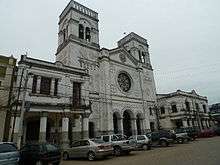Trinidad (Bolivia)
Understand

Cathedral, at plaza in Trinidad
Trinidad has a small-town feel to it.
- 🌍 Tourist Information. M-F 09:00-18:00, break during noon. Information on tours and tour operators in the surrounding regions, rivers and rainforests.
Get in
By bus
- Santa Cruz <=> Trinidad: Bs. 50-80 (semi-cama), 10-12 hr
- San Ignacio de Moxos <=> Trinidad: Bs. 30-60 by bus or van (shared taxi, leave when full, several connections daily), 2-3 hr. On the way, Mamore river must be crossed by ferry.
- Rurrenabaque: Take a shared taxi from the old terminal in Rurrenabaque to San Borja, and change there to go directly to Trinidad or via San Ignacio de Moxos (another change).
- Riberalta: You can take a chain of shared taxis via Guayaramerín and San Joaquín (only in dry season), it's about Bs. 300 and takes 12 hr plus waiting time to change.
- San Joaquín: A shared taxi is Bs. 100 and takes 4 hr.
By plane
You can fly to Trinidad with Amaszonas from Riberalta (500 Bs.) and Santa Cruz.
Get around
Motorbike taxis (Bs. 4) dominate over regular taxis.
See
- Casco Viejo (north of town). A historic farm, with typical colonial constructions.
- Plaza Mariscal José Ballivián.
- Pompéia Bridge. Wooden bridge.
- Trinidad Cathedral.
- Museo Kenneth Lee (at the edge of town near the exit north, at the road to San Joaquin). Ethnoarcheological museum, where you can see regional costumes (mostly on dolls), and find some information (photos, models) over the ancient hydro-civilization of Beni. You can jump in i.e. if you wait for a shared taxi to San Joaquin and have some spare time. There is no official price, pay a guy there something to support the museum. It may stink petrol inside the main building, because they wash the floor with it (or a mix) to kill bacteria.
Do
- Balneário de Tapacaré, in Laguna Suárez.
- Pre-hispanic hills (lomas). Platforms constructed around 5,500 years ago by various civilizations for purposes of irrigation, today they are important archeological sites for the ancient local cultures. The most impressive ones are Loma Suarez and Loma Chuchini.
- 🌍 Loma Suárez (12 km northeast from Trinidad on the banks of the Ibare River. You can reach Loma Suarez by moto taxi (Bs. 15)). A human-made hill close to the originally believed to have been built by the Moxos Civilisation. It is now an army village and you might need an ID to get in. Nothing very impressive the hill itself. But the view from the hill is rewarding. You can also eat some nice fish (Bs. 30) or take a there-and-return boat ride in Ibare River (to see animals you have to go by boat further).
- 🌍 Loma Chuchuni (Chuchini Ecolodge y Wildlife Reserve) (just 5 km north of Loma Suárez). A private but badly run ecological reserve with animals held in cages and such. Probably not worth the support and widely overpriced (also the accommodation which is beyond US$200), but check it out by yourself it is close to Loma Suárez. US$10 (privately owned).
- Take Mamore river boat trip. Jump on a cargo boat and go to Guayaramerín, at the border with Brasil. This is unforgettable experience to see river Mamore and surroundings (the river is winding), and to experience daily life of cargo boat men. The trip may take 5-7 days in dry season, when there's less water in the river. With more water, the trip is faster, i.e. 3 days. Boats leave when full. For where and when to jump in, ask at Distrito Naval (naval neighborhood; 6 de Agosto corner Meliton Villavicencio) in Trinidad. Look for captainships (capitanias) for ports Almacen and Barador. They will direct you to a corresponding port, or maybe port Heralda. Go there, and deal the price directly. With information, guys in Beni tourist information office can help too, but then they'll direct you to "distrito naval".
Buy
Eat
Small bars serve breakfast (i.e. close to where shared taxis leave to San Joaquin or Guayaramerin): meat, chocolate (local cocoa drink), empanadas.
Drink
Sleep
- Residencial Santisima Trinidad. 60 Bs. for a bed in triple room.
- Aguahí, ☎ +591-3 46-25570.
- Cochabamba, ☎ +591-3 46-22811.
- Ganadero, ☎ +591-3 46-21644.
- Monte Verde, ☎ +591-3 46-22750.
Go next

On the way to San Joaquin
- Santa Cruz de la Sierra – Economic center and the biggest city in Bolivia. Not very spectacular in itself, but serves as a gateway to Chiquitania and Brasil, Sucre. Go there by bus or fly with Amaszonas for 650 Bs.
- San Ignacio de Moxos – A little mission town with nice church and local Moxos community. When celebrate (town fiesta), Moxos people wear impressive costumes.
- Riberalta – Interesting city in the North. Two big rivers join there. The ground (dust) is of red color and makes an impression. One can explore the city or visit surroundings (i.e. rubber boom city or native community at a lake).
- San Joaquin, and other towns to the north – You can find some "hidden gems" there. You can go there by shared taxi or a plane, or you can stop (i.e. change taxis) on your way to Guayaramerin or Riberalta. These towns have their fiestas close in time, but on different days, so if you're a party type of person, you can go partying from one town to another.
gollark: Also, you could... get that quite easily on STM32/ESP32/whatever boards?
gollark: i.e. they nominally are but you cannot actually get them for that much, especially in quantity.
gollark: It's probably "$4" like the Pi Zero is "$5".
gollark: Technically, you can emulate any chip ever with sufficient computing power.
gollark: How would stuff work *better* hot? Doesn't that increase electromigration and evil badness?
This article is issued from Wikivoyage. The text is licensed under Creative Commons - Attribution - Sharealike. Additional terms may apply for the media files.